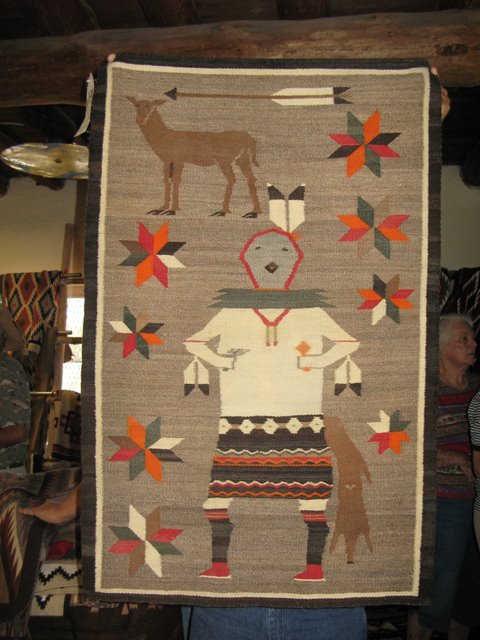An Early Ye’i Bi Chei Weaving
The handsome weaving above was offered at the Smoki Museum Navajo rug auction last weekend. It’s the earliest depiction of a Ye’i Bi Chei dancer that I’ve seen and I thought you might enjoy a look at it too. It dates to the late 1890’s or early 1900’s and is done in the style of a weaver named Yanapah Simpson. Yanapah was married to a trader and lived in Farmington, New Mexico, but traders in Lukachukai, Arizona and Shiprock, New Mexico were also known to have encouraged the weaving of figural rugs during this period. The dancer is surrounded by Valero stars, an influence from Rio Grande weaing, and a very lifelike deer. The weaving skill in this piece is phenomenal, with crisp, straight lines and sides and wonderful detailing in the kilt and deer figure.
These pieces were quite controversial at the time with many Navajo people believing that depictions of deities and ceremonies should be off limits as weaving subjects, particularly when they were offered for sale. This belief still persists among many weavers and those who weave Ye’i and Sandpainting rugs often have ceremonies done to protect them from any ill effects. On the other hand, I’ve also heard at least one weaver downplay the potential for trouble, saying “I’m a Presbyterian, so I don’t believe it’s a problem”. For most Navajo people, however, these figures remain very powerful and a recent exhibit of Sandpainting rugs carried a warning that traditional Navajos might find the display offensive.
The Ye’i Bi Chei are also called Winter Gods and Grandfather Spirits (which is what the name means in Navajo) and are the focus of healing ceremonies held in the Fall and early Winter. During these ceremonies, the dancers take on the role of intermediaries between the gods and the human race. The ceremony continues over the course of several days, with some portions open to the public. The most accessible of these is held in early October at the Shiprock Fair.

